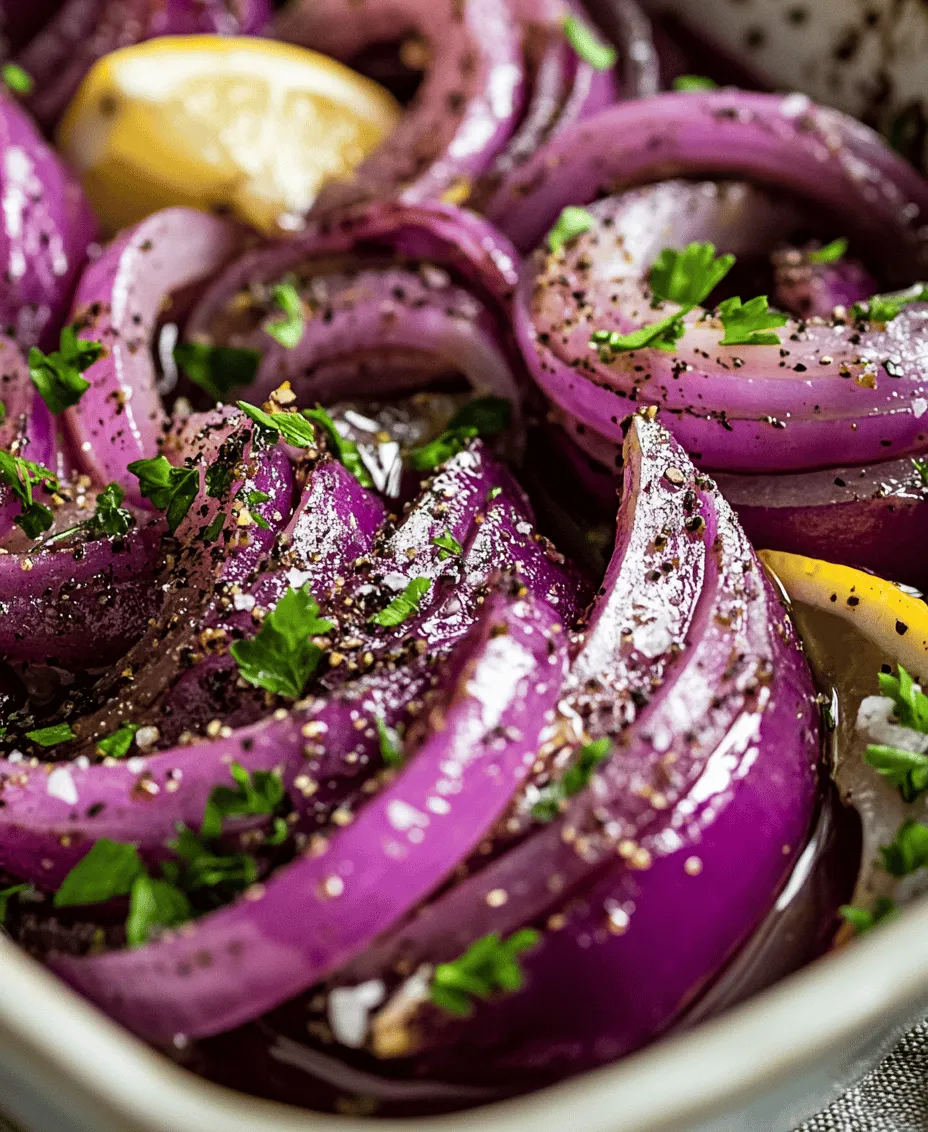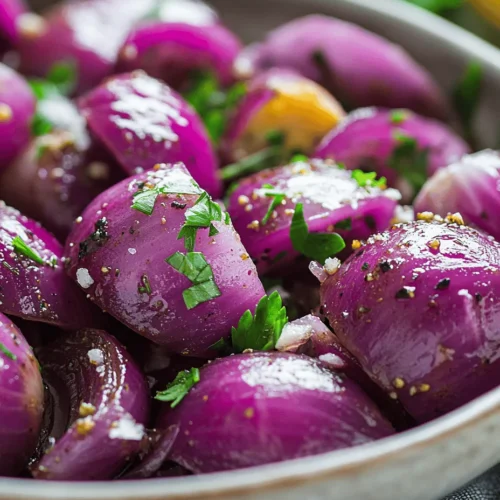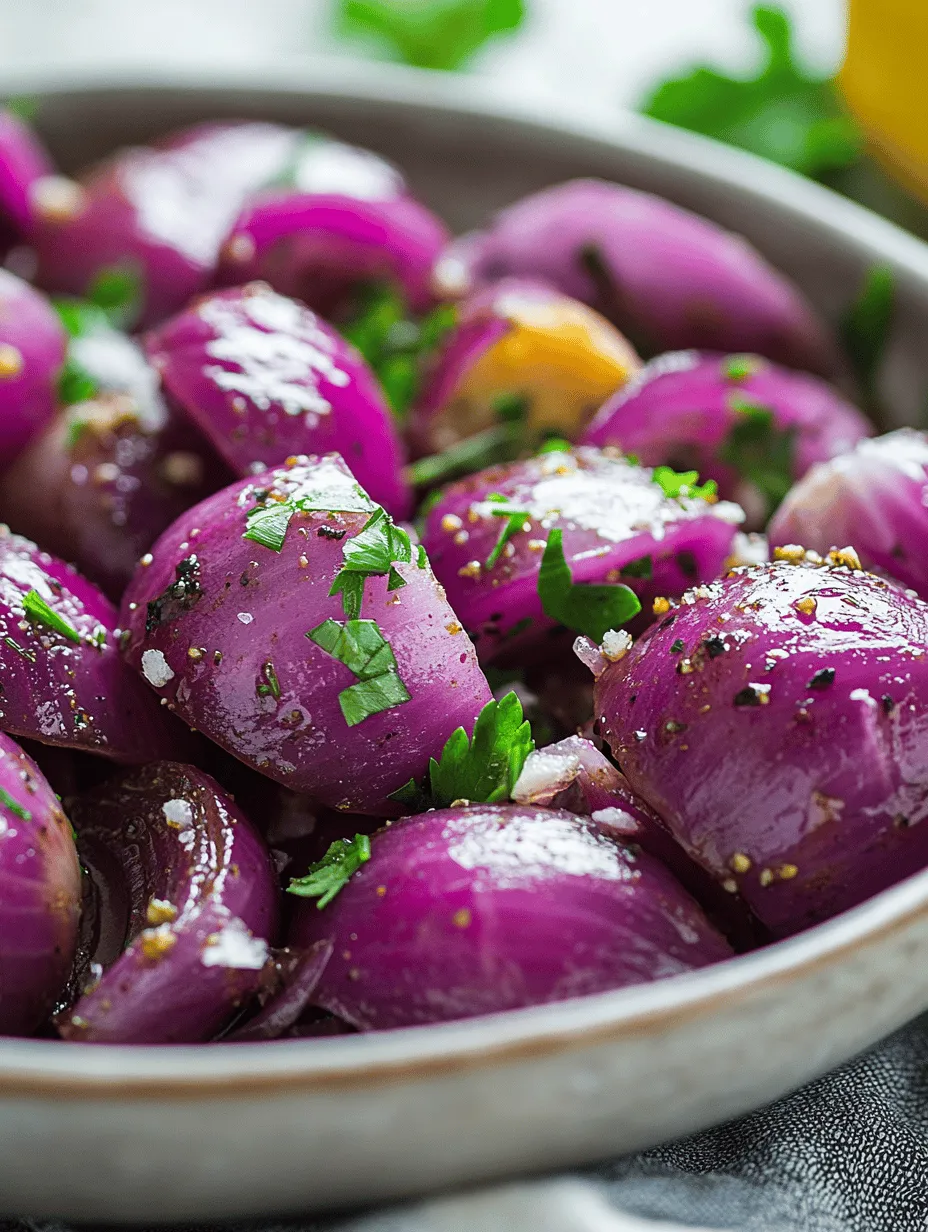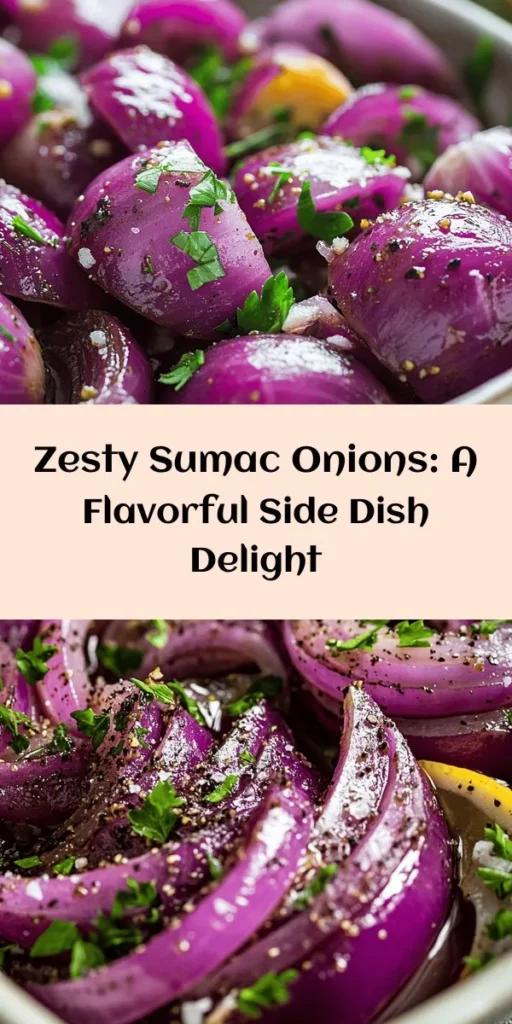Introduction
If you’re looking for a vibrant and flavorful side dish that complements a wide range of meals, then look no further than zesty sumac onions. This recipe not only elevates the humble onion to new heights but also highlights the unique flavor of sumac, a spice that adds a delightful tang to any dish. In culinary traditions across the globe, onions have held a prominent place, utilized for their ability to enhance flavors and provide depth to various recipes. The combination of zesty sumac with onions creates a dish that is not only delicious but also visually appealing, making it a perfect addition to any dinner table.
The Role of Onions in Culinary Traditions
Onions have been a staple ingredient in kitchens around the world for centuries. From the robust and aromatic yellow onion to the sweet and crisp red onion, these versatile bulbs are celebrated for their ability to transform any dish with their layered flavors. Onions are foundational in many cuisines, serving as the base for soups, stews, sauces, and salads. Their natural sweetness, when cooked, enhances savory dishes, while raw onions add a refreshing crunch and sharpness.
The red onion, in particular, stands out for its vibrant color and sweet flavor, making it an excellent choice for salads and garnishes. Its crisp texture and mild bite make it a favorite among chefs and home cooks alike. Incorporating red onions into your meals not only enhances the taste but also adds a pop of color, making your dishes more visually appealing.
Sumac: A Unique Spice with a Tangy Flavor Profile
Sumac is a spice that has been used in Middle Eastern cuisine for centuries and is gaining popularity in culinary circles around the world. Known for its deep reddish-purple hue and tangy flavor, sumac is derived from the dried and ground berries of the sumac plant. Its tartness is often compared to that of lemon or vinegar but offers a unique depth that sets it apart.
The use of sumac dates back to ancient civilizations, where it was prized for its flavor and health benefits. Today, it is commonly used to season meats, salads, and vegetables, imparting a refreshing acidity that brightens dishes. When combined with red onions, sumac creates a harmonious balance, enhancing the natural sweetness of the onions while adding a zesty kick.
The Benefits of Incorporating Zesty Sumac Onions into Meals
Zesty sumac onions are not just about flavor; they also offer a range of health benefits. Onions are rich in vitamins, minerals, and antioxidants, making them a valuable addition to any diet. They are known for their anti-inflammatory properties and can aid in digestion. When paired with sumac, which is known for its antioxidant and anti-inflammatory properties as well, this dish becomes a powerhouse of nutrients.
The zesty sumac onions can be served as a side dish, a topping for grilled meats, or even as a flavorful addition to wraps and sandwiches. Their versatility makes them a perfect companion to a variety of cuisines, from Mediterranean to American. Whether you’re hosting a dinner party or simply looking to elevate your weekday meals, zesty sumac onions are sure to impress.
Understanding the Ingredients
To create this flavorful side dish, it’s essential to understand the role of each ingredient used in the recipe. Here is a closer look at the key components that make up zesty sumac onions.
Red Onions: Flavorful and Nutritious
Red onions are the star of this dish, bringing both flavor and color. They are known for their slightly sweet and mild flavor, which becomes more pronounced when cooked. Nutritionally, red onions are a great source of vitamins C and B6, manganese, and dietary fiber. They are also rich in antioxidants, particularly quercetin, which has anti-inflammatory properties.
In the culinary world, red onions are incredibly versatile. They can be used raw in salads, pickled, caramelized, or roasted, making them a staple ingredient in many kitchens. Their vibrant color adds visual appeal to dishes, while their flavor profile complements a wide range of ingredients.
Extra Virgin Olive Oil: A Flavor Enhancer
Extra virgin olive oil is another crucial ingredient in this recipe. This high-quality oil is extracted from olives using cold-pressing methods, preserving its natural flavors and health benefits. Olive oil is renowned for its heart-healthy properties, rich in monounsaturated fats and antioxidants that can help reduce inflammation and lower cholesterol levels.
In terms of flavor, extra virgin olive oil brings a fruity and peppery note to dishes, enhancing the overall taste profile. When used in this recipe, it helps to soften the onions and allows the flavors of the other ingredients to meld beautifully.
Exploring Sumac Spice: Origin and Flavor Profile
As mentioned earlier, sumac is a unique spice that adds a tangy brightness to dishes. It has its roots in Middle Eastern cuisine, where it has been used for centuries to enhance the flavor of meats, salads, and dips. The sumac plant thrives in Mediterranean climates, and its berries are harvested and dried before being ground into a coarse powder.
The flavor of sumac is both tart and slightly fruity, making it an excellent addition to dishes that require a zesty kick. Its acidity can brighten up rich foods, creating a well-balanced dish. Sumac is often used in spice blends, salad dressings, and marinades, showcasing its versatility in the kitchen.
The Significance of Sea Salt
Sea salt is a fundamental ingredient in cooking, known for its ability to enhance flavors. Unlike regular table salt, sea salt is harvested from evaporated seawater and contains trace minerals that can contribute subtle flavor variations. Using sea salt in this recipe will not only bring out the natural sweetness of the onions but also balance the acidity from the sumac and lemon juice.
Salt plays a crucial role in cooking by helping to intensify flavors. It can draw out moisture from ingredients, allowing for more concentrated flavors and enhancing the overall taste of the dish. Various types of salt, such as kosher salt and Himalayan pink salt, can be used in cooking, but sea salt is preferred for its clean taste and mineral content.
Lemon Juice and Honey: Balancing Acidity and Sweetness
The addition of lemon juice is essential in this recipe, as it provides a bright acidity that balances the sweetness of the red onions and the richness of the olive oil. Lemon juice is a natural flavor enhancer and adds a refreshing note to the dish. Moreover, the acidity from lemon juice helps to tenderize the onions, making them more palatable and enjoyable.
Honey, or alternatively maple syrup, is included to provide a touch of sweetness that rounds out the dish. The sweetness from honey or maple syrup counteracts the tanginess of the sumac and the acidity of the lemon juice, creating a well-balanced flavor profile. Both honey and maple syrup come with their own health benefits, offering natural sweetness without the refined sugars found in many processed foods.
Fresh Parsley: A Flavorful Garnish
Finally, fresh parsley is the finishing touch in this recipe. Not only does it add a burst of color and freshness to the dish, but it also contributes its own unique flavor. Parsley is rich in vitamins A, C, and K, making it a nutritious addition to meals. Its bright, slightly peppery taste complements the zesty sumac onions beautifully.
Garnishing with fresh herbs is an essential aspect of food presentation. It not only enhances the visual appeal of the dish but also adds layers of flavor that elevate the dining experience. Fresh parsley can be chopped and sprinkled over the zesty sumac onions just before serving to add a vibrant touch.
Step-by-Step Guide to Making Zesty Sumac Onions
Now that we have explored the ingredients and their significance, it’s time to dive into the step-by-step process of making zesty sumac onions. This dish is simple to prepare and can be ready in no time, making it a perfect side for any meal.
Preparing the Onions
The first step in creating zesty sumac onions is preparing the red onions. Start by peeling the outer skin and trimming the ends. For maximum flavor release, it’s essential to slice the onions properly.
1. Slicing Techniques: To achieve the best flavor, slice the onions thinly. Using a sharp knife, cut the onions in half from top to bottom, then lay them flat on the cutting board. Slice them into thin half-moons. The thinner the slices, the quicker they will absorb the flavors of the dressing, and the more delicate the texture will become.
2. Soaking the Onions: If you find raw onions to be too pungent, consider soaking the sliced onions in cold water for about 10 minutes. This will mellow their flavor and make them more palatable. After soaking, drain the onions and pat them dry with a paper towel to remove excess moisture.
Combining the Ingredients
Once the onions are prepared, it’s time to combine them with the other ingredients to create the zesty sumac onion dish.
1. Mixing the Dressing: In a large bowl, combine the sliced red onions with extra virgin olive oil, fresh lemon juice, honey (or maple syrup), and a generous sprinkle of sumac. The proportions can be adjusted based on personal taste, but a good starting point is about 2 tablespoons of olive oil, the juice of one lemon, 1 tablespoon of honey, and 2 teaspoons of sumac.
2. Tossing to Combine: Gently toss the onions with the dressing until they are well coated. The olive oil will help to soften the onions, while the lemon juice and honey will create a flavorful marinade that penetrates the layers of the onion.
3. Seasoning with Sea Salt: Finally, add a pinch of sea salt to enhance the overall flavor. Mixing the salt well will ensure an even distribution, allowing each bite of zesty sumac onions to burst with flavor.
By following these initial steps, you are well on your way to creating a vibrant and tangy dish that will surely impress your family and friends. As you prepare to serve zesty sumac onions, consider how they can complement a variety of main courses, from grilled meats to roasted vegetables. The next part of the recipe will delve into additional tips for achieving the perfect balance of flavors and presentation.

Importance of Massaging Spices into Onions
When preparing zesty sumac onions, one crucial technique that elevates the dish is massaging the spices directly into the onions. This method not only ensures that every slice is evenly coated but also promotes a deeper infusion of flavors. By gently rubbing the spices into the onions, you break down the cell walls of the onions, allowing the spices to penetrate more effectively. This results in a harmonious blend of flavors that enhances the overall taste experience.
Massaging the spices also influences the texture of the onions. The gentle pressure applied during this process softens the onions slightly, making them more palatable in raw dishes. This transformation is especially significant when using red onions, which can sometimes have a sharp bite. The massaging technique mellows their intensity, balancing the raw flavor with the zesty tang of sumac and other spices.
The Marinating Process
After massaging the onions with the spices, the next step is marination. Marinating the zesty sumac onions allows the flavors to meld and develop further. During this crucial phase, the onions soak up the tangy, citrusy notes of the sumac while also becoming more tender. This process is essential for achieving a vibrant, flavor-packed dish.
Why Marination is Crucial for Flavor Development
Marination serves as a flavor-building technique that enhances the overall profile of the dish. The acids present in sumac and the olive oil not only season the onions but also help to soften their fibers, leading to a more enjoyable texture. The longer the onions are allowed to marinate, the more pronounced the flavors become. This step is particularly important when serving the dish raw, as the marination reduces the sharpness of the onions while allowing the zesty notes to shine through.
Tips for Timing and Temperature During Marination
For optimal results, marinate the zesty sumac onions for at least 30 minutes, though 1-2 hours is ideal. If time allows, letting them marinate overnight in the refrigerator can intensify the flavors even further. However, keep in mind that onions can become overly soft if marinated for too long, so finding the right balance is key.
The temperature during marination also plays a significant role. Marinating at room temperature allows the flavors to meld more quickly but be cautious to not leave them out for too long, especially in warm environments. If marinating overnight, always refrigerate to keep them fresh and safe.
Adjusting Flavors Post-Marination
Once the marination period is complete, taste the zesty sumac onions before serving. This is an essential step that allows you to adjust the seasoning to your preference. Depending on your taste, you may want to add a pinch more salt, a drizzle of olive oil, or an extra sprinkle of sumac to enhance the dish.
How to Taste and Adjust Seasoning Effectively
To taste and adjust seasoning effectively, use a clean spoon to take a sample of the marinated onions. Consider the following:
– Salt: If the dish feels flat, a touch more salt can often elevate the flavors.
– Acidity: If it needs brightening, a squeeze of fresh lemon juice can enhance the zesty profile.
– Heat: For those who enjoy a bit of spice, adding a pinch of red pepper flakes or a dash of hot sauce can provide a nice contrast to the sweetness of the onions.
Personalizing the Dish Based on Taste Preferences
One of the beautiful aspects of zesty sumac onions is their versatility. This dish can be easily tailored to fit different palates. For a sweeter profile, consider adding a touch of honey or maple syrup during the marination process. If you prefer a more savory flavor, incorporating garlic or freshly chopped herbs like parsley or cilantro can add a delightful depth.
Serving Suggestions
Zesty sumac onions are not only delicious but also incredibly versatile. Here are some ideas on how to serve them:
– As a Side Dish: These onions make a fantastic accompaniment to grilled meats, fish, or roasted vegetables. Their bright flavor cuts through rich dishes, adding balance and freshness.
– Pairing with Main Courses: Zesty sumac onions pair beautifully with Middle Eastern dishes such as shawarma, kebabs, or falafel. They can also complement Mediterranean staples like grilled chicken or fish, providing a burst of flavor.
– Creative Uses in Salads or Wraps: Incorporate the marinated onions into salads for added crunch and flavor. They can be a star ingredient in a grain bowl or wrap, bringing brightness to the mix.
– Presentation Tips for an Appealing Platter: When serving zesty sumac onions, consider presenting them in a colorful dish, garnished with fresh herbs or slices of lemon. This not only enhances the visual appeal but also invites people to dig in.
– Importance of Visual Appeal in Food: Food that looks appealing is often more enjoyable to eat. A well-presented dish can elevate the dining experience, making it more memorable. Use vibrant colors and garnish thoughtfully to create an enticing platter.
Nutritional Benefits of Zesty Sumac Onions
Zesty sumac onions are not only flavorful but also pack a powerful nutritional punch. Here’s a closer look at the health benefits of each ingredient:
– Onions: Rich in vitamins C and B6, onions are known for their antioxidant properties. They support heart health, improve digestion, and may even boost immunity.
– Sumac: This tangy spice is high in antioxidants and has anti-inflammatory properties. It can aid in digestion and is often used as a natural remedy for various ailments.
– Olive Oil: A staple of the Mediterranean diet, olive oil is known for its heart-healthy fats. It contains anti-inflammatory compounds and is linked to numerous health benefits, including reduced risk of chronic diseases.
How This Dish Can Fit into Various Diet Plans
Zesty sumac onions can easily fit into a variety of dietary preferences, including Mediterranean, vegan, and gluten-free diets. They are a great option for those looking to incorporate more plant-based foods into their meals, providing flavor and nutrients without excessive calories.
Benefits of Consuming Raw Onions and Spices
Raw onions offer unique health benefits compared to their cooked counterparts, including higher levels of certain vitamins and minerals. Combining them with spices like sumac not only enhances flavor but also boosts health benefits, making this dish both delicious and nutritious.
Culinary Variations and Adaptations
To keep your zesty sumac onions exciting, consider experimenting with variations:
– Different Types of Onions: While red onions are typically used, you can also try yellow or white onions for a different flavor profile. Green onions or shallots can provide a milder alternative.
– Adjusting Spice Levels: For those who prefer less heat, reduce the amount of sumac or omit it entirely. Alternatively, if you enjoy a bolder flavor, consider adding more sumac or even incorporating spices like cumin or coriander to the mix.
– Alternative Dressings or Additional Ingredients: Enhance the dish by adding ingredients like diced tomatoes, cucumbers, or bell peppers during the marination process. This not only adds texture but also gives a refreshing twist to the dish.
Cultural Context and Popularity
Sumac is a staple in many Middle Eastern cuisines, known for its bright, tangy flavor that complements a variety of dishes. Its use dates back centuries, making it a historical ingredient that has stood the test of time. The growing popularity of Middle Eastern flavors in modern cooking has brought sumac to the forefront, encouraging home cooks to experiment with its unique taste.
Onions, too, have a rich history, being one of the oldest cultivated crops. They are a common ingredient across various cultures, used in countless recipes worldwide. The combination of onions and spices reflects the culinary practices of many regions, showcasing how simple ingredients can create complex flavor profiles.
Conclusion
Zesty sumac onions are a delightful addition to any meal, offering a burst of flavor and a wealth of nutritional benefits. Their versatility allows for creative serving options, making them suitable for various occasions and dietary preferences. Whether enjoyed on their own, as a side dish, or incorporated into other recipes, these zesty onions are sure to impress.
Exploring and enjoying different onion dishes can open up a world of culinary possibilities. With their vibrant flavor and simple preparation, zesty sumac onions exemplify how uncomplicated ingredients can create extraordinary results. Embrace the versatility of this dish and let your taste buds experience the delightful fusion of flavors that zesty sumac onions have to offer.



